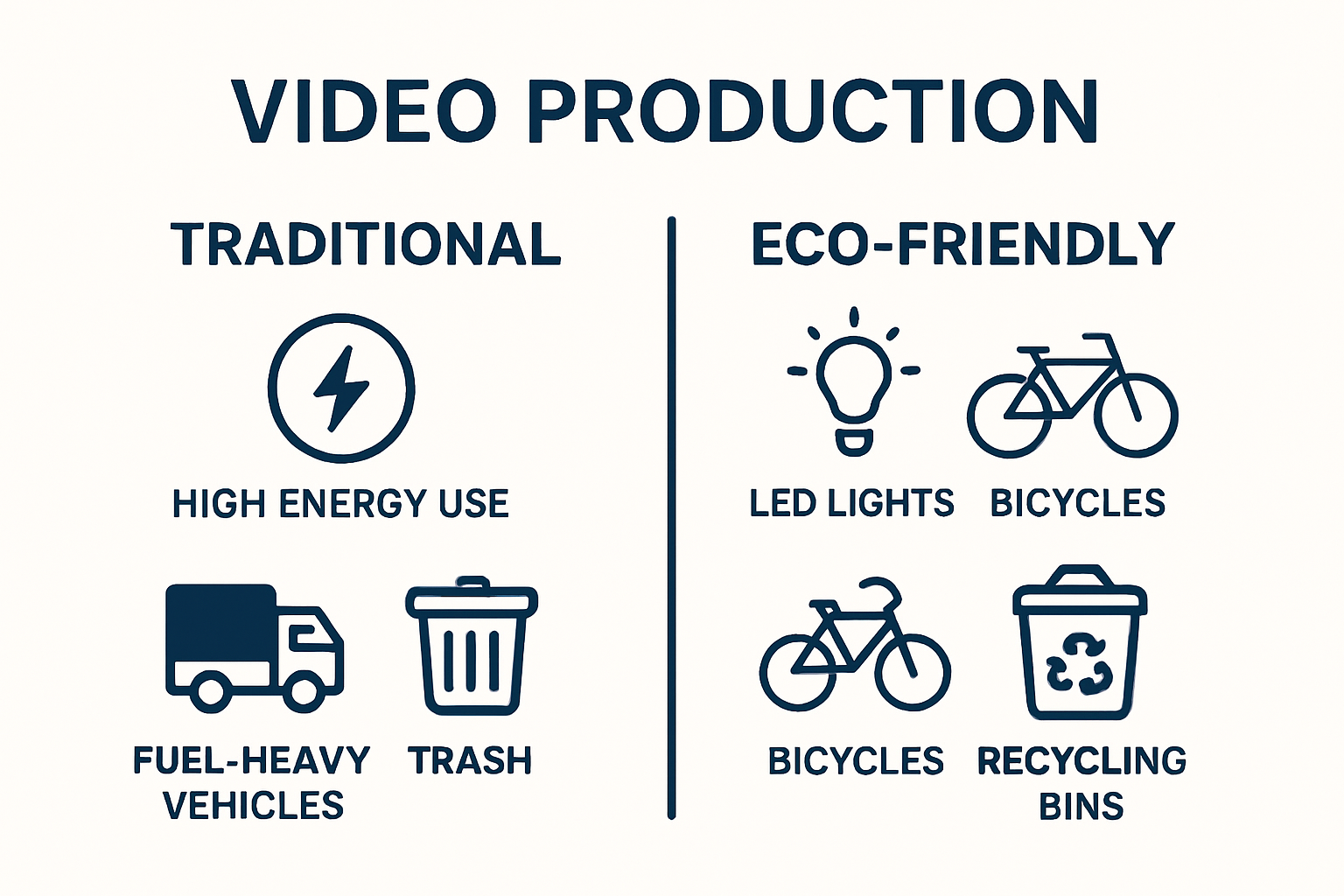Understanding Eco Friendly Video Production for Filmmakers
- info1419758
- Sep 18
- 7 min read

Eco friendly video production is changing the way people think about filmmaking. Most assume shooting a movie is a creative process with little real world impact but the numbers tell a different story. One feature film can generate up to 500 metric tons of carbon dioxide emissions. What surprises many is that these sustainable film sets are proving you can cut waste and costs while making movies that look just as stunning on screen.
Table of Contents
Quick Summary
Takeaway | Explanation |
Eco friendly video reduces carbon footprint. | Incorporating energy-efficient technologies minimizes emissions throughout production stages. |
Waste minimization is crucial. | Implementing reusable equipment and recycling enhances sustainability and creates zero waste workflows. |
Sustainable practices lower operational costs. | Eco-friendly methods can cut energy usage and waste management expenses significantly. |
Green technologies enhance production quality. | Innovations like solar-powered equipment and digital workflows optimize resources while maintaining high creative standards. |
Documentaries showcase environmental responsibility. | Films addressing ecological issues not only inform but also embody sustainable production practices. |
Defining Eco Friendly Video: Key Principles and Concepts
Eco friendly video production represents a transformative approach to media creation that prioritizes environmental sustainability throughout the entire filmmaking process. Unlike traditional video production methods, this approach considers the ecological footprint of every stage from pre production to final distribution.
Environmental Impact of Traditional Video Production
Traditional video production generates significant environmental waste. A typical film shoot can produce substantial carbon emissions through equipment transportation, excessive energy consumption, single use plastics, and wasteful on set practices. Sustainable Production Alliance reports that an average feature film can generate up to 500 metric tons of carbon dioxide equivalent emissions.
Key environmental challenges in conventional video production include:

High energy consumption from lighting and equipment
Substantial transportation related carbon emissions
Significant material waste from set construction and disposable supplies
Inefficient resource management during shooting
Core Principles of Eco Friendly Video Production
Eco friendly video production involves strategic approaches that minimize environmental impact while maintaining creative excellence. These principles focus on comprehensive sustainability across multiple production dimensions:
Reducing Carbon Footprint: Implementing energy efficient technologies and minimizing transportation emissions
Waste Minimization: Using reusable equipment, recycling materials, and designing zero waste workflows
Green Technology Integration: Leveraging renewable energy sources and sustainable digital workflows
By reimagining production processes through an environmental lens, filmmakers can create compelling content while demonstrating corporate social responsibility and environmental stewardship.
Below is a comparison table highlighting the environmental impact of traditional video production versus eco friendly video production across key parameters.
Aspect | Traditional Video Production | Eco Friendly Video Production |
Carbon Emissions | High due to transportation and energy use | Significantly reduced with efficient technology |
Energy Consumption | Extensive, especially for lighting | Lower via LED and solar-powered equipment |
Material/Waste | Large amounts, single-use plastics common | Uses reusable and recyclable materials |
Workflow | Often inefficient, little resource tracking | Optimized, includes carbon and waste tracking |
Environmental Accountability | Minimal, not a priority | Core operational strategy, well-documented |
The goal is not just reducing negative impacts but actively contributing to ecological preservation through conscious creative choices.
Understanding eco friendly video requires recognizing that sustainability is not a limitation but an opportunity for innovation.
Here is a table summarizing the core principles and strategies that define eco friendly video production and their primary benefits.
Principle/Strategy | Description | Primary Benefit |
Reducing Carbon Footprint | Use of efficient tech, minimizing travel | Lower emissions |
Waste Minimization | Reusable equipment, recycling, zero waste workflows | Less landfill waste |
Green Technology Integration | Solar power, digital workflows, LED lighting | Energy/resource savings |
Remote Collaboration | Virtual production tools and remote workflows | Reduced travel and costs |
Efficient Resource Allocation | Precise scheduling and resource management | Optimizes crew/equipment use |
Carbon Tracking | Monitoring emissions and offsetting where possible | Transparent sustainability |
The Importance of Sustainable Practices in Video Production
Sustainable practices in video production are rapidly transforming from optional considerations to critical industry standards. As environmental consciousness grows, filmmakers and media professionals recognize the profound impact their creative processes have on global ecological systems.
Environmental and Economic Implications
Video production is not traditionally considered an environmentally intensive industry, but the cumulative environmental footprint is substantial. NYC Mayor’s Office of Media and Entertainment highlights that a single film production can generate significant waste and carbon emissions through multiple operational channels.
Key environmental challenges in video production include:
Extensive energy consumption during shooting and post production
High carbon emissions from equipment transportation
Substantial material waste from set construction
Single use plastic and equipment consumption
Strategic Benefits of Sustainable Production
Implementing sustainable practices offers multifaceted advantages beyond environmental protection. Forward thinking production companies are discovering that ecological responsibility can simultaneously reduce operational costs and enhance brand reputation.
Strategic benefits include:
Cost Reduction: Lower energy consumption and waste management expenses
Brand Positioning: Demonstrating corporate environmental commitment
Talent Attraction: Appealing to environmentally conscious creative professionals
Regulatory Compliance: Preparing for increasingly strict environmental regulations
By integrating sustainable methodologies, video production teams can create meaningful change. This approach transforms environmental responsibility from a peripheral concern to a core operational strategy, proving that creative excellence and ecological stewardship can coexist harmoniously.
This table organizes the strategic benefits of adopting sustainable production practices in video production, showing how each advantage supports both business and environmental goals.
Strategic Benefit | Explanation |
Cost Reduction | Cuts energy, resource, and waste disposal costs |
Brand Positioning | Enhances reputation for environmental responsibility |
Talent Attraction | Appeals to eco conscious professionals and freelancers |
Regulatory Compliance | Eases adaptation to future environmental regulations |
Creative Opportunity | Fosters innovation through new sustainable workflows |
The future of video production lies not just in technological innovation, but in developing holistic practices that respect and preserve our planetary resources. Sustainable production is no longer a choice but an essential evolution of the creative industry.

How Eco Friendly Video Production Works: Techniques and Innovations
Eco friendly video production transforms traditional filmmaking through innovative techniques that minimize environmental impact while maintaining high production quality. This approach integrates cutting edge technologies and strategic methodologies to create sustainable media creation processes.
Sustainable Production Technologies
Modern eco friendly video production leverages advanced technologies designed to reduce carbon footprint and optimize resource utilization. Green Production Guide highlights several breakthrough technologies enabling more sustainable filmmaking practices.
Key technological innovations include:
Digital workflow systems reducing physical document usage
Energy efficient LED lighting replacing traditional high consumption equipment
Solar powered production equipment and charging stations
Cloud based collaboration platforms minimizing travel requirements
Workflow Optimization Strategies
Eco friendly production goes beyond technological solutions by reimagining entire workflow structures. Production teams now implement comprehensive strategies that integrate sustainability into every production stage.
Critical workflow optimization approaches include:
Remote Collaboration: Utilizing virtual production technologies
Efficient Resource Allocation: Precise equipment and crew scheduling
Comprehensive Recycling Protocols: Implementing zero waste production practices
Carbon Tracking: Measuring and offsetting production related emissions
These sophisticated approaches demonstrate that sustainable production is not about limitation but about intelligent redesign. By rethinking traditional production methodologies, filmmakers can create compelling content while significantly reducing environmental impact.
The future of video production lies in continuous innovation, where technological advancement and ecological responsibility converge. Creative professionals who embrace these principles will lead the industry toward a more sustainable and responsible future.
Real-World Examples of Eco Friendly Video in Action
Real world examples demonstrate the transformative potential of eco friendly video production, showcasing how creative professionals are implementing sustainable practices across various media platforms. These practical applications prove that environmental responsibility can be seamlessly integrated into storytelling and content creation.
Documentary and Educational Video Initiatives
Documentary filmmakers are at the forefront of environmental storytelling, using video as a powerful medium to raise awareness and inspire action. Environmental Film Festival highlights groundbreaking documentaries that not only address ecological challenges but also embody sustainable production principles.
Notable examples of impactful environmental video include:
Films exploring climate change impacts on global communities
Documentaries showcasing innovative environmental solutions
Storytelling that connects scientific research with human experiences
Multimedia projects highlighting grassroots environmental movements
Corporate and Brand Sustainability Storytelling
Leading corporations and brands are increasingly using video content to communicate their sustainability commitments. These productions go beyond traditional marketing by demonstrating genuine environmental stewardship and transparent reporting of ecological initiatives.
Sustainability video strategies involve:
Transparent Reporting: Documenting real sustainability progress
Employee Engagement: Showcasing internal environmental efforts
Consumer Education: Explaining complex sustainability concepts
Impact Visualization: Creating compelling narratives about environmental contributions
These examples illustrate that eco friendly video is more than a production technique it is a powerful communication tool. By combining creative storytelling with genuine environmental commitment, video creators can inspire meaningful dialogue and drive positive ecological change across global audiences.
Power Your Next Shoot With Sustainable Swiss Expertise
Making the shift to eco friendly video production is inspiring, but executing green filmmaking in a new country can feel overwhelming. Maybe you worry about high costs, local permit headaches, or finding reliable sustainable practices in Switzerland. The article highlighted challenges like minimizing your carbon footprint and managing complex logistics without sacrificing creativity or production quality. At Video Production Switzerland, we help international filmmakers turn environmental goals into practical, stress free results. Our local crews understand sustainable production demands and deliver zero surprise solutions.

Ready to bring your eco conscious vision to life without logistical roadblocks? Connect with our team for a free consultation and discover how we handle crew sourcing, permits, equipment, and accommodations for responsible shoots. Visit our landing page and start planning your next project today. The sooner you act, the sooner you can set a new standard for sustainable filmmaking in Switzerland.
Frequently Asked Questions
What is eco friendly video production?
Eco friendly video production is a filmmaking approach that prioritizes environmental sustainability by minimizing the ecological footprint throughout the entire production process, from pre-production to distribution.
What are the key principles of eco friendly video production?
Key principles include reducing carbon footprint, minimizing waste through reusable equipment and recycling, and integrating green technologies like renewable energy and efficient workflows.
How can filmmakers reduce their environmental impact during production?
Filmmakers can reduce their environmental impact by implementing energy-efficient lighting, using sustainable materials, optimizing travel and transportation logistics, and adopting digital workflows to limit resource consumption.
Why is sustainability important in video production?
Sustainability is essential in video production because it helps to reduce carbon emissions, minimize waste, and promote corporate social responsibility. Moreover, it offers strategic benefits such as cost reduction, improved brand reputation, and compliance with regulations.
Recommended

Comments